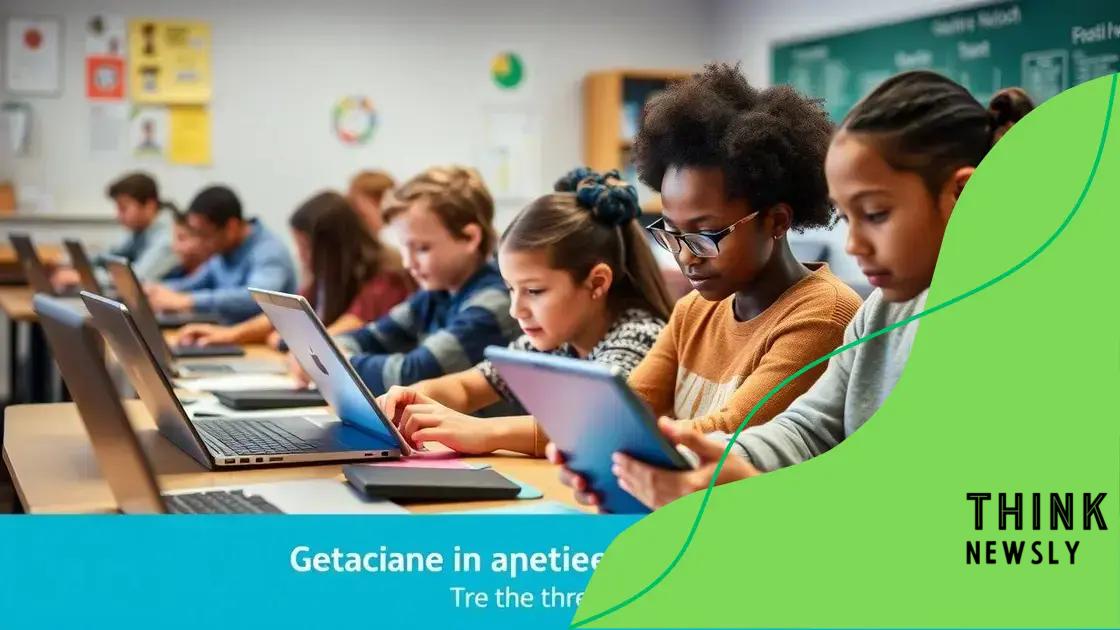Graduation numbers climb as education transforms lives

Anúncios
Graduation numbers climb due to improved access to education, enhanced support systems, and advancements in technology, although challenges like job market competition and student loan debt persist for new graduates.
Graduation numbers climb each year, revealing significant changes in the educational landscape. Have you ever wondered how these rising statistics truly affect students’ futures? Let’s dive into this compelling topic.
Anúncios
The rise in graduation rates: a global perspective
The rise in graduation rates has been a notable trend worldwide. With changes in educational policies and increased access to resources, many students are completing their studies. This phenomenon reflects a broader commitment to education and its importance in personal and professional development.
Global Trends in Graduation Rates
In various regions, graduation rates have significantly improved. For instance, countries like Finland and Japan have long boasted high graduation rates due to their education systems. Not only does this elevate educational standards, but it also promotes economic growth and social stability.
- Increased enrollment in higher education
- Support programs for at-risk students
- Global initiatives focused on educational equity
Moreover, the availability of online learning options has made education more accessible. Students can pursue degrees at their own pace, which is particularly beneficial for those who balance work and study. This flexibility promotes a higher graduation rate, as it accommodates diverse learning styles and needs.
Anúncios
Impact on Societal Development
As graduation numbers climb, the impact on society becomes more evident. Educated individuals contribute positively to their communities, fostering innovation and collaboration. Countries with higher graduation rates often experience lower crime rates and increased civic engagement.
- Better job opportunities and economic stability
- Enhanced community involvement and volunteerism
- Reduction in poverty levels
The relationship between education and empowerment is profound. When more individuals graduate, entire communities benefit. Increased education levels lead to a more informed citizenry that values critical thinking and social responsibility. Therefore, as we observe this rise in graduation rates, it symbolizes hope for a brighter future.
Factors driving the increase in graduations
Several key factors are driving the increase in graduation rates worldwide. Understanding these elements can help us appreciate how educational systems evolve to meet the needs of students.
Accessibility of Education
One of the primary reasons for higher graduation numbers is the improved accessibility of education. Schools and universities are expanding their outreach programs, making it easier for students from diverse backgrounds to enroll. This accessibility leads to more students entering and completing educational programs.
- Scholarships and financial aid opportunities
- Online courses offering flexible learning
- Community outreach for underrepresented groups
With these resources, students who might have faced barriers in the past now have opportunities to pursue their education.
Support Systems for Students
Another crucial factor is the enhancement of support systems within educational institutions. Many schools now offer mentoring programs, tutoring, and counseling services. These systems help students navigate challenges, ensuring they stay on track to graduate.
- Mentorship programs connecting students with professionals
- Counseling services for mental health and academic advice
- Peer support groups fostering a sense of community
When students feel supported, they are more likely to succeed and graduate. The connection between support and success cannot be overstated.
Changing Attitudes Toward Education
Finally, cultural shifts toward valuing education have played a significant role. Families today recognize the importance of education for future success. This change in mentality encourages more students to commit to their studies and pursue higher education.
Additionally, the increasing demand for skilled workers in the job market pushes students to achieve their educational goals. As industries evolve, they seek employees with advanced knowledge and skills, making graduation a critical step for many.
Impact of technology on education and skills

The impact of technology on education and skills is profound and far-reaching. In recent years, digital tools have transformed the way students learn and educators teach.
Enhanced Learning Experiences
Technology provides students with access to information like never before. Online databases, e-books, and educational videos make learning more engaging. Students can explore topics in-depth and at their own pace, fostering a deeper understanding.
- Interactive learning platforms that promote engagement
- Virtual simulations for real-world application
- Online discussions connecting global perspectives
As a result, education becomes not just about memorizing facts but about developing critical thinking and problem-solving skills. This shift prepares students for the complex challenges of today’s world.
Skills Development for the Future
With technology, students gain essential skills needed for the modern workforce. Familiarity with digital tools is crucial. Many employers look for candidates who can navigate software and understand data analytics.
- Digital literacy for workplace readiness
- Collaboration tools enhancing teamwork skills
- Online certifications supporting career advancement
As education integrates more technology, students cultivate skills that are vital for their professional success. The workforce is evolving, and so must education.
Access to Diverse Resources
Technology also breaks down barriers to education. Resources that were once limited to certain regions are now available globally. Students can learn from renowned experts through online courses and webinars.
This democratization of information empowers learners everywhere, ensuring they can develop their skills regardless of their location. When combined with traditional education, technology creates a comprehensive learning environment.
Challenges still faced by graduates today
Despite the rise in graduation numbers, many graduates still face significant challenges as they enter the workforce. Understanding these hurdles is crucial in supporting new graduates as they transition into their careers.
Job Market Competition
One of the biggest challenges for recent graduates is the intense competition in the job market. With so many qualified candidates vying for the same positions, it can be difficult for new graduates to secure employment.
- High numbers of applicants for each job opening
- Demand for experience often outweighs educational qualifications
- Emerging technologies creating new skill requirements
This means graduates often need to find unique ways to stand out, such as internships or volunteer opportunities, to enhance their resumes.
Student Loan Debt
Another significant obstacle is the burden of student loan debt. Many graduates leave colleges and universities with substantial financial obligations. This debt can limit their career choices and financial freedom as they start their adult lives.
- Difficulty in managing monthly loan payments
- Impact on credit scores and future financial decisions
- Pressure to find high-paying jobs quickly
For many, the stress of debt can overshadow the excitement of graduation and make financial planning a critical concern.
Workplace Preparedness
Graduates also often face challenges related to workplace preparedness. While they may possess theoretical knowledge, the practical skills needed in the workplace can vary widely. Employers frequently indicate that new hires may lack crucial soft skills.
Graduates must adapt to professional settings, where teamwork, communication, and time management are essential. As institutions aim to prepare students for the future, bridging this gap remains a priority.
Future predictions for graduation trends
As we look ahead, predicting graduation trends involves analyzing current data and societal shifts. Several key factors will likely shape the future of graduation rates and educational attainment.
Increased Accessibility to Education
One major prediction is that access to education will continue to grow. With the expansion of online learning platforms, more students can pursue degrees regardless of their location. This trend allows for a more inclusive approach to education.
- More institutions offering online degree programs
- Flexible learning options catering to working students
- Growth of community colleges providing affordable education
Increased access means that graduation rates could continue to rise as barriers to entry diminish.
Emphasis on Lifelong Learning
Another significant trend is the shift towards lifelong learning. As industries evolve, there is a growing awareness that education should not end at graduation. Continuous skill development will become crucial.
- More professionals seeking additional certifications
- Companies offering training and development programs
- Incorporation of short courses and workshops in curricula
This emphasis on lifelong learning prepares individuals for rapid changes in the job market, helping them remain competitive.
Impact of Technology
Advancements in technology will play a critical role in shaping graduation trends. As educational tools become more sophisticated, learning experiences will improve. Technology will facilitate personalized learning, making it easier for students to succeed.
Future classrooms may include virtual reality environments for hands-on training and artificial intelligence tools to assist with individualized study plans. As these technologies become mainstream, they will likely contribute to higher graduation rates.
FAQ – Frequently Asked Questions About Graduation Trends
What are the primary factors driving the increase in graduation rates?
Key factors include improved access to education, better support systems, and advancements in technology that enhance learning experiences.
What challenges do recent graduates face today?
Recent graduates often encounter job market competition, student loan debt, and a lack of workplace preparedness, making the transition to employment challenging.
How will technology impact future graduation trends?
Technology will likely enable more personalized learning, increase access to educational resources, and facilitate continuous skill development, making education more effective.
What is the significance of lifelong learning for graduates?
Lifelong learning is crucial as it allows graduates to continually update their skills, ensuring they remain competitive in an ever-evolving job market.





